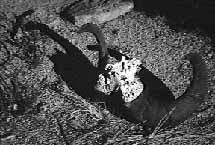|
|

© copyright 2003 Michael P.
Hamilton, Ph.D.
The desert dance
of predator and prey

December 27, 1996:
I'm sure it had been raining hard all
night in Idyllwild, but above our campsite ten miles
outside
of Borrego Springs, the storm merely generated a luminescent
veil of creamy gray-tones that chased a piercing winter
solstice
moon. Ten rain drops were enough to compel me to put
the rain
fly on the tent during the middle of the night, but
the morning
sunrise, and waves of gently warming air, meant we
could wear shorts
and tank tops while most of southern California put
up with wind,
rain, mud slides and traffic jams. It seemed as if
the desert canyons
beckoned us to visit until we readied our fanny-packs,
watched
looming rain clouds engulf the higher distant peaks,
and then set
out for a morning hike to discover whatever Mother
Nature deemed
willing to show. Today that lesson would be one of
Earth's most ancient
stories, the struggle for life and the inevitability
of death.
Anza Borrego Desert State Park will always be one
of
my favorite wilderness areas. Encompassing nearly
a million
acres of wild lands, we can thank the vision of wilderness
preservationists
like Harry James for recognizing that people need
a place of such
expansiveness and wildness to temporarily release
us from the
shackles of civilization and refresh our souls with
a deep
cleansing breath of nature. As a naturalist, I'm in
a sense no
different, I crave wild places after spending too
much time
looking at the same trees outside my office window,
or after the
fourth trip down to Hemet in the same week begins
to lose its fascination!

desert peninsular bighorn sheep in Anza Borrego Desert State Park
The canyon we choose to hike was called Bitter Creek
Canyon, and
my curiosity about the name only added to the need
to explore a
new environment. Like so many desert washes, this
canyon bore
evidence of extremes -- in flooding, drought, heat,
and cold. The
wash was home to numerous resident and migrant birds
and
mammals. The black-crested Phainopepla boldly defended
its
feeding territory of mistletoe infested Creosote bushes,
munching on the toxic fruit and flaunting his natural
immunity,
while unknowingly spreading sticky seeds through his
feces, and
thereby extending the range of the tenacious plant
parasite. The
first flowers of the rainy season were from the Chuparosa,
a
perennial shrub whose dense red inflorescence and
ample
nectar provide a winter-long food supply for the Anna's
Hummingbird. While a pair of Rough-legged Hawks soared
above our heads, the tracks of Black-tailed Jack Rabbit,
Merriam's Kangaroo Rat, Coyote, and Mule Deer crisscross
the
sandy wash suggesting they were participants in an
all-night dance marathon.

Golden Eagle
Further up the canyon, I caught a glimpse of movement
while
pondering the presence of a lone Cottonwood tree growing
high upon the wall of the north-facing slope. Training
binoculars
on the point of movement, my "gestalt" reflex
told me "Golden Eagle,"
yet it wasn't until about five minutes later that
the huge bird
launched herself from a hiding place and proved my
hunch. The
eagle flew low and slow down canyon over our heads
as she
caught a warm updraft, tipping her wings into the
thermal air
bubble and began an ascent that rapidly lifted the
magnificent
bird to an altitude of several hundred feet.
Curiosity over the eagle brought us to the base of
the slope
where we noticed peculiar vertical lines extending
many feet
from the lone tree to near the spot where the eagle
had lifted off.
The lines turned out to be a series of metal and plastic
pipes
supplying a steadily dripping source of water to an
old claw
foot bathtub. This "wildlife guzzler" was
a tool to enhance the
survival of wildlife by providing water at times when
the desert
can literally be as dry as a bone. Even the best desert-adapted
animal needs water, whether it comes from a natural
spring or
juicy vegetation, to survive. Range managers built
these low-tech
water systems decades ago to keep cattle alive, but
the real
beneficiaries have been the Mule Deer and Bighorn
Sheep and
Golden Eagles, and the hundreds of other species whose
survival is
measured in the day to day struggle to find food,
water and shelter.
We soon noticed large numbers of sun-bleached bones
scattered
around the guzzler and even more near the Cottonwood
tree and
willows that grew densely around the spring. Finding
intact
skeletons of Mule Deer and Bighorn Sheep, and smaller
bones
from many other species, set off my intuitive "red
light" as I
realized we had just walked right into the dining
room of a Mountain
Lion! I checked the black mud surrounding the spring
for sign of
fresh lion tracks but was only mildly relieved to
find nothing
recent. The desert drama that had played out around
us was
exciting enough to imagine without coming face to
face with
the big kitty that called this place home. Walking
back to camp,
my mind and spirit recharged by the heady emotions
gleaned
from this timeless desert dance of survival between
predator and
prey, I felt an overwhelming sense of wilderness.

previous journal entries
|